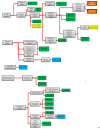Brain Correlates of the Alcohol Use Disorder Pharmacotherapy Response: A Systematic Review of Neuroimaging Studies
- PMID: 35326342
- PMCID: PMC8946664
- DOI: 10.3390/brainsci12030386
Brain Correlates of the Alcohol Use Disorder Pharmacotherapy Response: A Systematic Review of Neuroimaging Studies
Abstract
Background: Although Alcohol Use Disorder (AUD) is highly prevalent worldwide, treating this condition remains challenging. Further, potential treatments for AUD do not fully address alcohol-induced neuroadaptive changes. Understanding the effects of pharmacotherapies for AUD on the human brain may lead to tailored, more effective treatments, and improved individual clinical outcomes.
Objectives: We systematically reviewed the literature for studies investigating pharmacotherapies for AUD that included neuroimaging-based treatment outcomes. We searched the PubMed, Scielo, and PsycINFO databases up to January 2021.
Study eligibility criteria, participants, and interventions: Eligible studies included those investigating pharmacotherapies for AUD and employing functional magnetic resonance imaging (fMRI), positron emission tomography (PET), single-photon emission computed tomography (SPECT), and/or proton magnetic resonance spectroscopy (H-MRS).
Study appraisal and synthesis methods: Two independent reviewers screened studies' titles and abstracts for inclusion. Data extraction forms were shared among all the authors to standardize data collection. We gathered information on the following variables: sample size; mean age; sociodemographic and clinical characteristics; alcohol use status; study design and methodology; main neuroimaging findings and brain-regions of interest (i.e., brain areas activated by alcohol use and possible pharmacological interactions); and limitations of each study.
Results: Out of 177 studies selected, 20 studies provided relevant data for the research topic. Findings indicate that: (1) Acamprosate and gabapentin may selectively modulate limbic regions and the anterior cingulate cortex; (2) Naltrexone and disulfiram effects may involve prefrontal, premotor, and cerebellar regions; (3) Pharmacotherapies acting on glutamate and GABA neurotransmission involve primarily areas underpinning reward and negative affective states, and; (4) Pharmacotherapies acting on opioid and dopamine systems may affect areas responsible for the cognitive and motor factors of AUD.
Limitations: Most of the studies were focused on naltrexone. A small number of studies investigated the action of disulfiram and gabapentin, and no neuroimaging studies investigated topiramate. In addition, the time between medication and neuroimaging scans varied widely across studies.
Conclusions: We identified key-brain regions modulated by treatments available for AUD. Some of the regions modulated by naltrexone are not specific to the brain reward system, such as the parahippocampal gyrus (temporal lobe), parietal and occipital lobes. Other treatments also modulate not specific regions of the reward system, but play a role in the addictive behaviors, including the insula and dorsolateral prefrontal cortex. The role of these brain regions in mediating the AUD pharmacotherapy response warrants investigation in future research studies.
Keywords: acamprosate; alcohol; disulfiram; gabapentin; naltrexone; neuroimaging; pharmacotherapy.
Conflict of interest statement
The authors declare no conflict of interest.
Figures



Similar articles
-
The Safety of Alcohol Pharmacotherapies in Pregnancy: A Scoping Review of Human and Animal Research.CNS Drugs. 2025 Jan;39(1):23-37. doi: 10.1007/s40263-024-01126-8. Epub 2024 Oct 10. CNS Drugs. 2025. PMID: 39388037 Free PMC article.
-
Strategies to increase implementation of pharmacotherapy for alcohol use disorders: a structured review of care delivery and implementation interventions.Addict Sci Clin Pract. 2019 Feb 12;14(1):6. doi: 10.1186/s13722-019-0134-8. Addict Sci Clin Pract. 2019. PMID: 30744686 Free PMC article. Review.
-
Integration of pharmacotherapy for alcohol use disorder treatment in primary care settings: A scoping review.J Subst Abuse Treat. 2023 Jan;144:108919. doi: 10.1016/j.jsat.2022.108919. Epub 2022 Oct 28. J Subst Abuse Treat. 2023. PMID: 36332528 Free PMC article.
-
Novel Agents for the Pharmacological Treatment of Alcohol Use Disorder.Drugs. 2022 Feb;82(3):251-274. doi: 10.1007/s40265-021-01670-3. Epub 2022 Feb 8. Drugs. 2022. PMID: 35133639 Free PMC article. Review.
-
Combined Pharmacotherapy and Cognitive Behavioral Therapy for Adults With Alcohol or Substance Use Disorders: A Systematic Review and Meta-analysis.JAMA Netw Open. 2020 Jun 1;3(6):e208279. doi: 10.1001/jamanetworkopen.2020.8279. JAMA Netw Open. 2020. PMID: 32558914 Free PMC article.
Cited by
-
Caudate gray matter volumes and risk of relapse in Type A alcohol-dependent patients: A 7-year MRI follow-up study.Front Psychiatry. 2023 Feb 15;14:1067326. doi: 10.3389/fpsyt.2023.1067326. eCollection 2023. Front Psychiatry. 2023. PMID: 36873223 Free PMC article.
-
Physiological Role of ATPase for GABAA Receptor Resensitization.Int J Mol Sci. 2022 May 10;23(10):5320. doi: 10.3390/ijms23105320. Int J Mol Sci. 2022. PMID: 35628132 Free PMC article.
-
Association between glucagon-like peptide-1 receptor agonists use and change in alcohol consumption: a systematic review.EClinicalMedicine. 2024 Nov 14;78:102920. doi: 10.1016/j.eclinm.2024.102920. eCollection 2024 Dec. EClinicalMedicine. 2024. PMID: 39764544 Free PMC article.
-
Nucleus accumbens functional connectivity changes underlying alcohol expectancies in bipolar disorder and prospective alcohol outcomes: a within-subject randomized placebo-controlled alcohol administration fMRI study.Front Neurosci. 2025 Apr 9;19:1549295. doi: 10.3389/fnins.2025.1549295. eCollection 2025. Front Neurosci. 2025. PMID: 40270761 Free PMC article.
-
Exploring the Frontiers of Neuroimaging: A Review of Recent Advances in Understanding Brain Functioning and Disorders.Life (Basel). 2023 Jun 29;13(7):1472. doi: 10.3390/life13071472. Life (Basel). 2023. PMID: 37511847 Free PMC article. Review.
References
-
- Global Burden of Disease Collaborative Network . Global Burden of Disease Study 2017 (GBD 2017) Results. Institute for Health Metrics and Evaluation (IHME); Seattle, DC, USA: 2018.
-
- American Psychiatric Association . DSM-5: Diagnostic and Statistical Manual of Mental Disorder. 5th ed. American Psychiatric Publishing; Washington, DC, USA: 2013.
-
- World Health Organization . ICD-10: International Statistical Classification of Diseases and Related Health Problems: Tenth Revision. 2nd ed. World Health Organization; Geneva, Switzerland: 2004.
-
- Degenhardt L., Charlson F., Ferrari A., Santomauro D., Erskine H., Mantilla-Herrara A., Whiteford H., Leung J., Naghavi M., Griswold M., et al. The global burden of disease attributable to alcohol and drug use in 195 countries and territories, 1990–2016: A systematic analysis for the Global Burden of Disease Study 2016. Lancet Psychiatry. 2018;5:987–1012. doi: 10.1016/S2215-0366(18)30337-7. - DOI - PMC - PubMed
Publication types
Grants and funding
LinkOut - more resources
Full Text Sources

